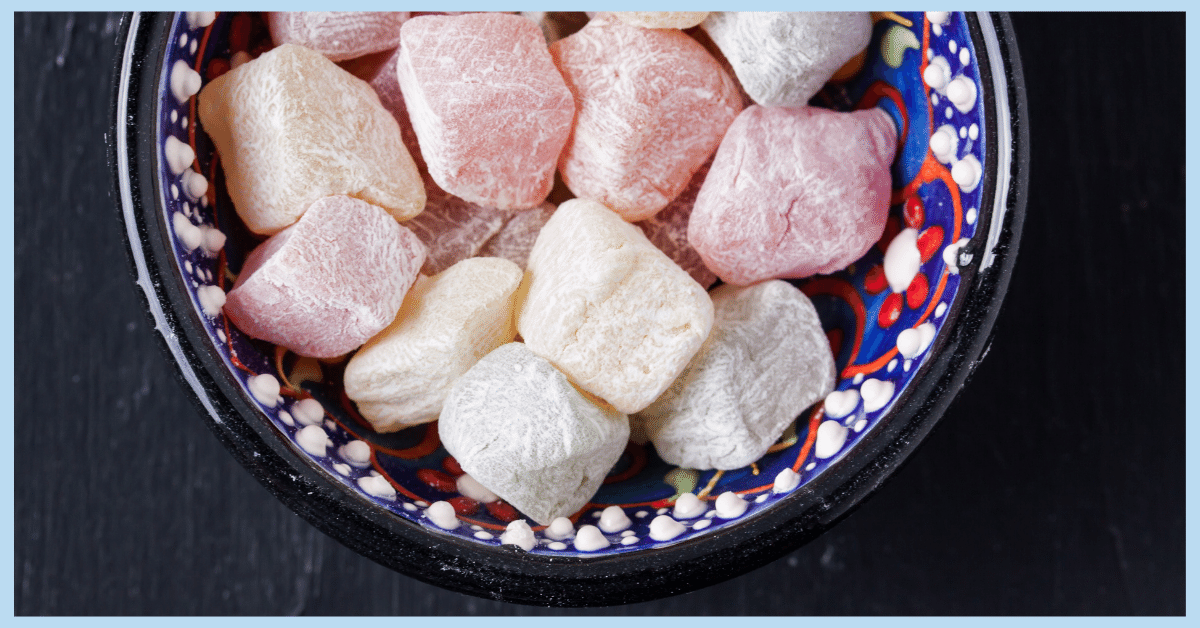Where is Turkish Delight from?
The modern Turkish Delight we enjoy today is surprisingly a lot different than the original Turkish Delight from more than 300 years ago. According to the history books, the Turkish sultan Abdul Hamid I ordered all of his confectionery specialists to experiment and develop a totally new, delicious dessert. The sultan was apparently famous for his secret recipes, so this was a happy addition.
Then in 1776, the same year the U.S. Declaration of Independence was ratified, an experienced Turkish confectioner named Haci Bekir Effendi made his way to Istanbul from a small town in rural Turkey. Eager to make his mark in the big city, he set up a small shop selling Turkish Delight.
FUN FACT: Haci’s shop still lives! It remained a family business and is now run by the fifth generation. It’s Turkey’s oldest company and one of the 100 oldest companies in the entire world!
Try Haci Bekir’s Turkish Delight here from Amazon (you seriously won’t regret it!).
Turkish Delight got so popular that eventually Turkish Delight reportedly first showed up in Europe at the 1837 Vienna Fair. And around the same time, an unknown British traveler loved Turkish Delight so much that he purchased and shipped big cases of it to Britain under the name Turkish Delight.
In these early years, Turkish Delight was made from honey or grape molasses and flour. Nowadays, with the invention of refined sugar and purified starch, its ingredients have changed quite a bit.
Why is it called Turkish Delight?
In Turkey, Turkish Delight has always been and still is called lokum (roughly pronounced low-koom). That unknown British traveler who loved lokum so much that he started selling it in Britain in the 19th century was actually the person who invented the name Turkish Delight.
Since then, the new name stuck and now that’s how most people refer to it today!
What is Turkish Delight made out of?
Turkish Delight has 3 main ingredients: sugar, starch, and water. The sugar is typically refined sugar and the starch is typically cornstarch. Then it’s up to the chef to add a tasty flavor like rose, cinnamon, or pistachio. For the non-nut flavors, confectioners usually infuse a flavored syrup. And if you want to get fancy with it, you can add chopped nuts, dried fruit, or even use honey instead of sugar to sweeten it.
What are the most common flavors of Turkish Delight?
The most common flavors of Turkish Delight are pistachio, rose, lemon, hazelnut, and plain. Everyone has different taste buds, but these are the flavors you’ll mostly see companies selling because they’re the more popular ones.
According to the Haci Bekir Effendi family, their two best-selling flavors are rose and pistachio.
If you love fruity flavors, give this one a try (from Amazon).
Is Turkish Delight healthy?
Because Turkish Delight is a sweet treat, it’s not healthy for you. Eating a lot of sugar every day over time can cause health problems like diabetes. But as long as you enjoy it in moderation (just like sugar in general), it shouldn’t harm your health.
If you’re vegan or vegetarian, Turkish Delight can be an awesome candy for you. Just make sure you’re not using ingredients or buying Turkish Delights that have pig gelatin in them or any other animal-based ingredients. In Turkey, Turkish Delight never has any pig products in it.
How bad is Turkish Delight for you?
Well, let’s just say Turkish Delight isn’t “good” for you. Like any other dessert, it’s high in carbohydrates and sugar. It also contains cornstarch, which isn’t healthy for you in large quantities.
One piece of Haci Bekir Effendi’s Turkish Delight contains about 39 calories, 8g of carbohydrates, and 7g of sugar. If a box comes with 32 pieces, that’s a total of 1248 calories, 256g of carbohydrates, and 224g of sugar.
Keep in mind that the American Heart Association recommends no more than 100 calories (about 25g) per day from added sugar for women and no more than 150 calories (about 36g) per day from added sugar for men.
Similar to other sweet treats, it’s important to enjoy Turkish Delight in moderation. That way, you’re not harming your health but you’re still able to delight in Turkish Delight.
What’s special about Turkish Delight?
Aside from tasting like little pieces of heaven, Turkish Delight is a uniquely enjoyable treat. It’s chewy so the flavor lasts, not too sweet, and it comes in a delightful arrangement of flavors that you should try at least once.
They’re so delicious it’s easy to eat an entire box in just one or two sittings. But they really should be eaten in moderation because they’re pretty sugary and don’t have any nutritional value.
Turkish Delight is loved around the world nowadays, which is impressive for a dessert cooked up over 300 years ago. It’s so ingrained in Turkish culture that you can find Turkish Delight shops scattered throughout neighborhoods in Istanbul and it’s even served with every Turkish coffee to cleanse and sweeten the palette.
In case you didn’t know, Turkish people love their desserts BIG time.
Where can you get Turkish Delight both inside and outside of Turkey?
The golden question! If you’re based in the U.S., I’d recommend purchasing the Haci Bekir brand of Turkish Delight here (delivered by Amazon).
If you’re in Turkey (or will be soon!), I’d recommend going directly to a Haci Bekir or Divan shop (my second favorite Turkish Delight brand) to get the best, most authentic Turkish Delight available!
If you’re outside of the U.S. and not planning to go to Turkey anytime soon, I’d recommend visiting your local Turkish supermarket (I’m sure they would sell Turkish Delight you could try).

